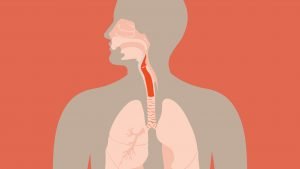Summary
The throat is composed of the larynx and pharynx, located behind the nose and extending downward to the lungs and stomach. These parts play essential roles in breathing, swallowing, and speaking, making their health crucial for overall well-being.
Throat cancer occurs when harmful cells grow uncontrollably within the tissues of the throat. This type of cancer becomes particularly serious when cancer cells grow excessively, outnumbering and damaging the healthy cells in the throat. Throat cancer can impact either the pharynx or the larynx and, if untreated, may spread to nearby tissues or organs, complicating treatment and overall prognosis.
Although the exact causes of throat cancer remain unknown, certain risk factors are strongly associated with its development. The main risk factors include smoking and excessive alcohol consumption, both of which have been shown to damage throat tissues and increase cancer risk. Common symptoms of throat cancer include difficulty swallowing, changes in voice, and coughing up blood. Early detection can make a significant difference, allowing for surgical removal of the tumor. For more advanced cases, radiotherapy and chemotherapy are often effective treatments to control and shrink the cancer.
Table of Contents
Symptoms of Throat Cancer
 Image Source: www.freepik.com
Image Source: www.freepik.com
Because there are different types of throat cancer, symptoms can vary, yet many of these cancers share common signs. Recognizing these early symptoms is crucial, as they can lead to timely diagnosis and treatment. The typical symptoms of throat cancer include:
- Difficulty swallowing. Persistent trouble with swallowing is one of the most common signs of throat cancer.
- Voice changes, particularly hoarseness. Hoarseness or a change in voice, especially if it persists, may signal an issue with the larynx.
- Chronic sore throat. A sore throat that doesn’t improve over time can be an indication of throat cancer.
- Unexplained weight loss. Sudden, unintentional weight loss can occur as the body uses extra energy to fight cancer.
- Swelling in the eyes, jaw, throat, or neck. These areas may swell due to tumor growth affecting surrounding tissues.
- Bleeding from the mouth or nose. Unexplained bleeding is often associated with advanced stages of cancer.
- Persistent cough. A long-lasting cough may signal irritation in the throat or lungs.
- Coughing up blood. Blood in the sputum can be a concerning sign that requires immediate medical attention.
- Non-healing lump or sore. A sore or lump in the throat area that doesn’t heal can be a red flag.
- Ear pain. Referred pain in the ears may occur due to nerve pathways shared with the throat.
While some of these symptoms may also be signs of other medical conditions, it’s essential to consult a healthcare provider if they persist. Early diagnosis is key to effective treatment and better outcomes in managing throat cancer.
Types of Throat Cancer
Throat cancer refers to cancer that affects the larynx and pharynx. These structures are located behind the nose and extend down toward the lungs and stomach. Though throat cancer cells are similar in type, the cancer is classified based on the specific area of the throat affected. The following are the main types of throat cancer:
- Nasopharyngeal cancer. This type begins in the nasopharynx, located at the upper part of the throat, just behind the nose. It connects the nasal passages to the rest of the throat.
- Oropharyngeal cancer. This cancer originates in the oropharynx, located in the middle part of the throat, behind the mouth, where the tonsils and base of the tongue are found.
- Hypopharyngeal cancer (laryngopharyngeal cancer). This cancer starts in the hypopharynx (or laryngopharynx), the lower section of the pharynx. It is situated above the esophagus and windpipe and is the area where food and air passages meet.
- Glottic cancer. This cancer begins in the vocal cords (glottis), affecting the tissue directly responsible for sound production.
- Supraglottic cancer. Originating in the upper part of the larynx, this type of cancer also includes cancers of the epiglottis, which acts as a lid to prevent food from entering the airway during swallowing.
- Subglottic cancer. This rare type of cancer starts in the lower part of the larynx, just below the vocal cords.
Understanding the specific type of throat cancer is important for determining the most effective treatment approach, as different areas of the throat may respond better to certain therapies. Early diagnosis and treatment tailored to the cancer’s location can significantly improve the prognosis.
Diagnostic Procedures for Throat Cancer
Diagnosing throat cancer involves a combination of physical examinations, imaging tests, and tissue biopsies. These procedures allow healthcare providers to assess any abnormalities in the throat, confirm the presence of cancer, and determine the cancer’s type and stage. Here are the primary diagnostic procedures for throat cancer:
1. Physical examination
A healthcare provider typically begins with a thorough examination of the throat, neck, and mouth, looking for any visible signs of abnormalities, such as lumps, swelling, or lesions. They may also check the lymph nodes for swelling, which can indicate the spread of cancer.
2. Endoscopy
An endoscopy allows doctors to directly view the throat and surrounding areas. During this procedure, a thin, flexible tube with a camera (endoscope) is inserted through the nose or mouth. This visual inspection helps locate tumors or other abnormalities. For a more detailed examination, a specialized endoscopy called a laryngoscopy may be used to specifically examine the larynx (voice box).
3. Imaging tests
Imaging tests help determine the size, location, and spread of any tumors. Common imaging tests for throat cancer include:
- CT scan (computed tomography). Produces detailed cross-sectional images of the throat, helping to identify tumor size and location.
- MRI (magnetic resonance imaging). Provides highly detailed images of soft tissues, which can reveal the extent of tumor involvement in surrounding tissues.
- PET scan (positron emission tomography). Often combined with a CT scan, a PET scan uses a special dye with radioactive tracers to identify cancerous cells and determine if cancer has spread to other parts of the body.
- X-rays. May be used to check for cancer spread to the chest or nearby structures.
4. Biopsy
A biopsy is the only definitive way to confirm throat cancer. In this procedure, a small tissue sample is taken from the suspicious area and examined under a microscope for cancer cells. Types of biopsies for throat cancer include:
- Fine-needle aspiration biopsy. Involves using a thin needle to remove a small tissue sample from a lump or swollen lymph node in the neck.
- Endoscopic biopsy. Tissue samples are collected during an endoscopy for laboratory analysis.
- Surgical biopsy. In some cases, minor surgery may be required to remove a larger sample or an entire lump for detailed examination.
5. HPV and EBV testing
Human papillomavirus (HPV) and Epstein-Barr virus (EBV) infections are risk factors for certain types of throat cancer. Testing for HPV or EBV can help determine if these viruses are contributing factors. Knowing the involvement of these viruses can guide treatment options, as HPV-positive throat cancers often respond differently to treatment.
A combination of physical exams, imaging, endoscopy, and biopsy provides a comprehensive approach to diagnosing throat cancer. These procedures allow healthcare providers to confirm the presence of cancer, identify its type, and determine its stage, which is essential for developing an effective treatment plan. Early diagnosis through these methods increases the chances of successful treatment and improves the overall prognosis for patients with throat cancer.
Complications of Untreated Throat Cancer
When left untreated, throat cancer can lead to a range of serious complications. These complications arise due to the cancer’s ability to spread to nearby tissues, lymph nodes, and even distant organs. Managing throat cancer early is essential to prevent these issues. Here are some common complications associated with untreated throat cancer:
1. Difficulty swallowing (dysphagia). As throat cancer progresses, tumors can block or narrow the throat, making it hard to swallow. This can lead to pain, malnutrition, and dehydration, as the patient may struggle to eat or drink properly. Dysphagia also increases the risk of aspiration, where food or liquids enter the lungs, potentially causing infections like pneumonia.
2. Breathing difficulties. Tumor growth in the throat or near the airway can make breathing increasingly difficult. In severe cases, the tumor may partially or fully block the airway, leading to a life-threatening situation that requires immediate intervention, such as a tracheostomy (surgical opening in the windpipe to assist with breathing).
3. Voice changes or loss of voice. If the cancer affects the larynx or vocal cords, it can cause hoarseness, changes in voice quality, or even complete loss of voice. This complication can significantly impact a person’s ability to communicate, affecting daily activities, social interactions, and quality of life.
4. Spread to nearby structures. Throat cancer can spread (metastasize) to nearby areas, including lymph nodes in the neck, the esophagus, and the lungs. This spread makes treatment more challenging and decreases survival rates. Cancer that spreads beyond the primary site often requires more intensive treatments, which may have higher risks and side effects.
5. Chronic pain. As tumors invade surrounding tissues and nerves, they can cause persistent pain in the throat, neck, or ears. This chronic pain may be difficult to manage and can significantly impact a person’s daily life and emotional well-being.
6. Nutritional deficiencies and weight loss. Difficulty swallowing and reduced appetite can result in malnutrition and rapid weight loss. Untreated throat cancer often causes significant physical decline, as the body lacks the nutrients needed to fight the disease and maintain energy levels.
7. Mental health challenges. The physical effects of throat cancer, combined with pain and difficulty speaking or eating, can lead to mental health challenges such as depression and anxiety. The stress of managing symptoms and the impact on daily life can significantly affect emotional well-being.
8. Increased risk of secondary infections. Blockages in the throat and impaired immune function make people with untreated throat cancer more susceptible to infections. Respiratory infections, including pneumonia, are particularly common and can complicate the cancer’s progression and treatment.
The complications of untreated throat cancer are severe and can impact nearly every aspect of a person’s life, from physical health to mental well-being. Early detection and timely treatment are crucial in managing throat cancer effectively and preventing these complications. A healthcare provider can help develop a treatment plan tailored to the patient’s needs, improving quality of life and survival outcomes.
Causes of Throat Cancer
 Image Source: labblog.uofmhealth.org
Image Source: labblog.uofmhealth.org
Throat cancer occurs when abnormal cells grow uncontrollably in the throat, eventually outnumbering and overtaking healthy cells. This abnormal cell growth leads to the formation of a mass or lump in the throat, known as a tumor. However, the exact cause of this cellular malfunction and why these abnormal cells develop in the first place remains unclear.
While the root cause is unknown, experts have identified several risk factors that increase the likelihood of developing throat cancer. These risk factors contribute to the development and progression of abnormal cell growth in the throat. The following sections of this article will discuss these risk factors in more detail. Understanding these risk factors can aid in early detection and prevention, especially for individuals with higher susceptibility to throat cancer.
Prevention of Throat Cancer
 Image Source: www.freepik.com
Image Source: www.freepik.com
Currently, there is no guaranteed way to prevent throat cancer, as its exact causes remain unidentified. However, reducing certain known risk factors can significantly lower one’s risk of developing this cancer. Here are some recommended preventive measures:
- Quit smoking. Smoking is one of the most significant contributors to throat cancer, as well as several other cancers, such as lung cancer. The harmful chemicals in cigarettes can damage cells in the throat, increasing the likelihood of abnormal cell growth. Quitting smoking is one of the most effective steps you can take to protect your throat and overall health.
- Limit alcohol consumption. Excessive alcohol intake increases the risk of various cancers, including throat cancer. If quitting entirely is not feasible, reducing alcohol intake is highly advisable. Consult a healthcare provider to determine safe drinking limits, as these may vary based on age and gender, and aim for moderation to help minimize cancer risk.
- Choose a nutrient-rich diet. A diet high in fruits and vegetables, especially those rich in antioxidants, supports cellular health and may help reduce cancer risk. Antioxidants combat oxidative stress, a factor in cancer development, and promote overall immune health. Incorporate a wide range of colorful produce to benefit from diverse vitamins and minerals.
- Practice safe sex. Engaging in oral sex with a partner who has the human papillomavirus (HPV) can increase the risk of throat cancer, as certain strains of HPV are linked to cancer development. Practicing safe sex by using dental dams and considering HPV vaccination can reduce this risk. The HPV vaccine is available for both men and women and is effective in preventing HPV strains that are known to cause cancer.
While these measures cannot fully eliminate the risk of throat cancer, they can substantially decrease it. Maintaining a healthy lifestyle, being cautious with lifestyle habits, and staying informed about preventive healthcare are all valuable steps toward reducing one’s risk of throat cancer and other health conditions.
Risk Factors for Throat Cancer
 Image Source: www.freepik.com
Image Source: www.freepik.com
The exact cause of throat cancer remains uncertain, but several factors are known to increase the risk of developing this condition. These include:
- Excessive alcohol consumption. Heavy drinking can damage cells in the throat, creating a higher risk for cancerous growths over time.
- Use of tobacco products, including chewing tobacco. Smoking and chewing tobacco introduce harmful chemicals that increase cancer risk in the throat and other areas of the body.
- Chronic acid reflux (gastroesophageal reflux disease, or GERD). Frequent acid reflux can irritate the throat lining, potentially contributing to abnormal cell growth and increasing cancer risk.
- Infection with the Epstein-Barr virus (EBV). This virus, which causes infectious mononucleosis, has been linked to an increased risk of certain throat cancers, particularly in the nasopharynx.
- Exposure to human papillomavirus (HPV). HPV, a sexually transmitted virus, is a known risk factor for throat cancer, particularly oropharyngeal cancer, due to its impact on cellular changes in the throat.
- Inherited genetic conditions, such as Fanconi anemia. Certain genetic disorders increase susceptibility to throat cancer due to weakened DNA repair mechanisms in affected cells.
These risk factors underscore the importance of maintaining healthy lifestyle habits and taking precautions to reduce exposure to potential cancer-causing agents. In the next section, we’ll discuss the possible complications that can arise from throat cancer, particularly when it is not diagnosed or treated promptly.
Throat Cancer FAQs
Here are some frequently asked questions about throat cancer to help you understand its symptoms, causes, treatments, and prevention.
1. What is throat cancer?
Throat cancer is a general term for cancers that develop in the throat, which includes the pharynx and larynx. It often begins when abnormal cells grow uncontrollably in areas like the vocal cords, tonsils, or other parts of the throat, forming a tumor. Throat cancer can include different types, such as nasopharyngeal, oropharyngeal, hypopharyngeal, and laryngeal cancers.
2. What are the common symptoms of throat cancer?
Common symptoms include persistent sore throat, difficulty swallowing, hoarseness, unexplained weight loss, ear pain, swollen neck lymph nodes, and coughing up blood. Early detection of these symptoms is important, so consult a healthcare provider if they persist.
3. What causes throat cancer?
The exact cause of throat cancer is unknown, but certain risk factors can increase the likelihood of developing it. These risk factors include smoking, excessive alcohol consumption, human papillomavirus (HPV) infection, Epstein-Barr virus (EBV) infection, and genetic conditions like Fanconi anemia.
4. Is throat cancer linked to HPV?
Yes, HPV (human papillomavirus) is a known risk factor for certain types of throat cancer, particularly oropharyngeal cancer. HPV infection can cause cellular changes in the throat, which may lead to cancer over time. Vaccination against HPV can help reduce this risk.
5. How is throat cancer diagnosed?
Diagnosis typically involves a physical examination, imaging tests (like CT, MRI, or PET scans), and an endoscopy to visually inspect the throat. A biopsy is usually performed to confirm the presence of cancer cells.
6. What are the treatment options for throat cancer?
Treatment options depend on the cancer’s type, stage, and location and may include surgery, radiation therapy, chemotherapy, or targeted therapy. In early stages, surgery or radiation alone may be effective, while more advanced stages may require a combination of treatments.
7. Is throat cancer curable?
Throat cancer is treatable, especially if detected early. The likelihood of successful treatment depends on factors like the cancer stage, type, and overall health of the patient. Early-stage cancers have higher cure rates, while advanced cancers may be managed to improve quality of life.
8. Can throat cancer be prevented?
While there is no guaranteed way to prevent throat cancer, reducing risk factors can help. This includes quitting smoking, limiting alcohol intake, maintaining a healthy diet, practicing safe sex to avoid HPV infection, and considering HPV vaccination.
9. Are there any complications associated with throat cancer?
Complications can include difficulty swallowing, voice changes, breathing issues, and, if untreated, the spread of cancer to other parts of the body. Early diagnosis and treatment can help prevent or minimize these complications.
10. What should I do if I suspect I have symptoms of throat cancer?
If you experience persistent symptoms such as a sore throat, difficulty swallowing, or hoarseness that lasts more than a few weeks, see a healthcare provider. Early evaluation can lead to timely diagnosis and a better treatment outlook.


